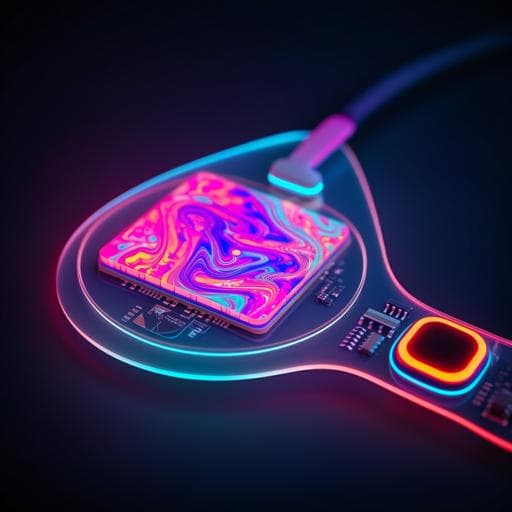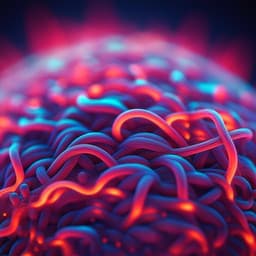
Medicine and Health
An artificial intelligence-assisted microfluidic colorimetric wearable sensor system for monitoring of key tear biomarkers
Z. Wang, Y. Dong, et al.
Discover the groundbreaking AI-WMCS, a wearable microfluidic sensor system that rapidly and non-invasively detects critical biomarkers in human tears. Developed by Zihu Wang, Yan Dong, Xiaoxiao Sui, Xingyan Shao, Kangshuai Li, Hao Zhang, Zhenyuan Xu, and Dongzhi Zhang, this innovative technology offers high accuracy using just a tiny tear sample!
~3 min • Beginner • English
Introduction
Human tears contain biomarkers relevant to ocular and systemic health (e.g., elevated vitamin C in early corneal injury; higher Ca2+ in dry eye). Abnormal protein levels and pH relate to diseases such as aniridia and rosacea. Rapid, accurate, and simultaneous monitoring of tear biomarkers is attractive but limited by a lack of reliable tear sensors. Electrochemical wearable tear sensors can be sensitive but require integration of electrodes, power, and wireless modules, increasing complexity, cost, and potential reliability and infection issues during on-body use. Microfluidic colorimetric sensors are simpler for data acquisition via smartphone imaging, but practical deployment is hindered by confounding effects: the natural tear pH range (∼6.0–8.0) alters chromogenic reactions, and ambient lighting (color temperature) introduces variability in captured color signals, degrading accuracy. This study proposes an AI-assisted wearable microfluidic colorimetric sensor system (AI-WMCS) that non-invasively collects tears under the eye and uses a smartphone-linked cloud server deep-learning pipeline to automatically interpret and correct colorimetric data for pH and color temperature, enabling fast, simultaneous quantification of vitamin C, H+ (pH), Ca2+, and proteins.
Literature Review
Prior wearable tear sensing has largely relied on electrochemical platforms (e.g., eyeglasses-mounted sensors for alcohol, vitamins, glucose via voltammetry), which complicate fabrication and can be less reliable on-body. Colorimetric microfluidic sensors have demonstrated strong performance in sweat for ions (chloride), metabolites (lactate, glucose), pH, nutrients (zinc, calcium, iron, vitamin C), and disease-related biomarkers. Contact lens-based colorimetric tear sensors and paper-based under-eye patches have been explored; contact lenses can cause discomfort and infection risk, whereas under-eye paper patches reduce eye contact and facilitate imaging. However, existing colorimetric approaches often involve cumbersome readout (e.g., conversion to chromaticity space) and remain susceptible to pH and lighting variation. Recent work shows machine learning can enhance colorimetric sensor performance (e.g., KNN-assisted Janus colorimetric mask for breath ammonia). The current work advances this by integrating a flexible PDMS microfluidic colorimetric tear sensor with a deep-learning cloud pipeline (CNN-GRU) explicitly designed to auto-correct for pH and ambient color temperature, addressing key bottlenecks noted in prior literature.
Methodology
Device and materials: A crescent-shaped flexible PDMS microfluidic patch (36 mm × 22 mm; thickness 1.5 mm) with a top PDMS sealing layer, PDMS microfluidic channel layer, and bottom medical adhesive collects tears under the eye. Tears flow by gravity to a central notch inlet and into four microchannels (800 µm × 800 µm) feeding circular micro-reservoirs (6 mm diameter; 800 µm thick). Filter paper chips treated with chromogenic reagents are mounted in each reservoir to detect vitamin C, pH (H+), Ca2+, and proteins. The patch adheres under-eye via medical adhesive, rapidly wicking fluid, filling reservoirs within ~4 s. Mechanical testing showed maximum tensile strain ~20.5% and maximum load ~232.7 kPa.
Colorimetric chemistries and calibration: Vitamin C detection uses reduction of 2,6-dichloroindophenol (DCIP), turning blue to colorless; red channel (R) intensity correlates with 0–1.2 mM vitamin C. pH sensing uses a mixture of methyl red, bromothymol blue, and phenolphthalein to cover pH 5.5–8.0; R varies monotonically with pH. Ca2+ detection uses o-cresolphthalein complexone (o-CPC) in AMP buffer with 8-hydroxyquinoline forming a purple complex; green channel (G) correlates with 0–5 mM Ca2+ (physiological ~0.4–1.1 mM). Protein detection uses TBPB undergoing protonation/deprotonation upon protein interaction shifting from yellow to blue; R correlates with 0–10 g/L protein (physiological ~3–7 g/L). Reaction stabilization studies showed minimal RGB change after 1 minute for all assays; thus 1-minute acquisition was used. Selectivity tests confirmed strong target specificity. Sensor pads stored at −4 °C retained performance (≤5% RGB variation) for at least 25 days.
Fabrication: PDMS layers were fabricated via a cut-and-paste mold process using stacked patterned copper films (16 layers) or PMMA molds. PDMS (Sylgard 184, 10:1) spin-coated and cured formed channel layers; plasma treatment bonded layers. 6 mm chromogenic paper chips were inserted into reservoirs. Channels were hydrophilicized with Silwet L-77 (1:99 in ethanol). A 3M double-sided medical adhesive backed the device for on-body use. Chromogenic pads were prepared by dosing filter paper with: DCIP ethanol solution for vitamin C; mixed BTB/PP/MR ethanol solution (10:5:1 molar ratio; BTB 2.5 mg/L) for pH; o-CPC and 8-hydroxyquinoline with AMP buffer for Ca2+ (4 µL deposited); and citric acid followed by TBPB solution for protein.
Data acquisition and preprocessing: A smartphone captured images of the four sensing regions after 1 min reaction. OpenCV identified each region of interest (ROI) and extracted RGB statistics from the whole colorimetric area, mitigating coffee-ring artifacts. RGB values were converted into feature signals per a defined feature set to construct datasets.
Deep-learning models and training: Six models were evaluated for concentration prediction: 3D-CNN-GRU, 3D-CNN, 3D-GRU, 1D-CNN-GRU, 1D-CNN, and 1D-GRU. Datasets were split into training:validation:test at 3:1:1. Features and targets were normalized. Models were trained until convergence (typically ~300 epochs), selecting the model with lowest validation loss. 3D-CNN-GRU showed best performance for vitamin C, Ca2+, and protein. A 1D-CNN-GRU was used for pH estimation from the pH sensor channel; a 4D-CNN-GRU was trained to predict ambient color temperature. The multichannel CNN-GRU architecture comprised per-channel convolutional layers with ReLU and pooling, feature concatenation, GRU layers for temporal dependencies, and a dense regression output layer. GRUs handle variable-length sequences inherent in different feature sets.
pH and color temperature correction workflow (CSDAS): Step 1: Train 1D-CNN-GRU on pH sensor data to predict pH; use predicted pH as a feature to train 3D-CNN-GRU models for vitamin C, Ca2+, and protein, generating pH-conditioned calibration. Step 2: Train 4D-CNN-GRU on datasets to predict color temperature; include color temperature as a feature. Retrain 1D-CNN-GRU for pH under different color temperatures and 3D-CNN-GRU for other analytes with both pH and color temperature features, achieving dual correction. The cloud server data analysis system (CSDAS) integrates image upload, ROI extraction, feature computation, model inference, pH/color temperature auto-correction, and result display on a smartphone.
Testing protocols: Standard solutions (20 µL) were introduced into the device; color images were captured at 1 min. Artificial tears were formulated with physiological salts, urea, dextrose, vitamin C (0–1.2 mM), Ca2+ (0–5 mM via CaCO3), and protein (albumin, 0–10 g/L), adjusted to pH 5.5–8.0. Experiments assessing lighting used a black box with tunable LED color temperatures (3000–6000 K). On-body tests were conducted with five healthy volunteers; a tear stick at the eye corner yielded 3–4 drops in ~10 s, with the patch removed at 1 min for imaging and cloud analysis. Numerical simulations estimated a 90% refresh time of ~60 s for a vitamin C step change (0→10 mM), indicating potential for future continuous monitoring.
Key Findings
- The multichannel deep-learning pipeline substantially corrected pH- and color temperature-induced errors, enabling accurate simultaneous quantification of pH, vitamin C, Ca2+, and proteins from tear-like samples with only ~20 µL.
- Model performance: 1D-CNN-GRU for pH prediction achieved test R² = 0.998 (MAE ≈ 0.001). 3D-CNN-GRU for vitamin C, Ca2+, and protein achieved overall best R² ≈ 0.994. Color temperature prediction with 4D-CNN-GRU reached R² = 0.996 with MAE ≈ 39.582 (K).
- After dual correction (pH and color temperature), test-set performance for each analyte (pH 6–8, 3000–6000 K): Vitamin C R² = 0.993, MSE = 0.001, MAE = 0.016; pH R² = 0.998, MSE = 0.001, MAE = 0.028; Ca2+ R² = 0.994, MSE = 0.019, MAE = 0.083; Protein R² = 0.996, MSE = 0.045, MAE = 0.142.
- Recovery in artificial tears: Uncorrected recoveries spanned 81.76–205.86% across sensors; CSDAS-corrected recoveries improved to 95.03–113.13% for all four analytes.
- Sensor response stabilized within 1 minute for all assays. The patch filled reservoirs in ~4 s. Mechanical tests: maximum tensile strain ≈ 20.5%, maximum load ≈ 232.7 kPa. Shelf-life at −4 °C showed ≤5% RGB variation for at least 25 days.
- On-body tests (n=5 healthy volunteers) yielded analyte levels within physiological ranges for all four biomarkers, supporting feasibility for real tear testing.
Discussion
The AI-WMCS addresses a key limitation of colorimetric tear sensing: susceptibility to variability in tear pH and environmental lighting. By estimating pH (1D-CNN-GRU) and color temperature (4D-CNN-GRU) and using these as conditioning features for the multichannel 3D-CNN-GRU analyte models, the system effectively normalizes colorimetric outputs across real-world conditions. This substantially improves accuracy and reliability, as evidenced by high test R² values across biomarkers and tightened recovery ranges in complex artificial tears. The flexible PDMS microfluidic patch enables comfortable, non-invasive tear collection under the eye, avoiding issues associated with contact lenses or complex electrochemical systems. The system’s fast response (1-minute readout) and low sample volume suit point-of-care and telehealth use. Integration with a cloud-based pipeline links wearable sensing to the IoT, facilitating rapid acquisition, processing, and display. The approach is generalizable to other biofluids (sweat, saliva, urine) and additional colorimetric targets, potentially broadening remote health monitoring applications.
Conclusion
This study demonstrates an artificial intelligence-assisted wearable microfluidic colorimetric sensor system (AI-WMCS) that enables rapid (1 min), non-invasive, and simultaneous monitoring of four key tear biomarkers (H+, vitamin C, Ca2+, proteins). A flexible PDMS microfluidic patch collects tears and houses colorimetric reactions, while a cloud server deep-learning pipeline (CSDAS) performs automated ROI extraction, feature computation, and dual correction for pH and ambient color temperature via CNN-GRU models. The system significantly improves concentration prediction accuracy (per-biomarker test R² ≥ 0.993 after correction) and narrows recovery to ~95–113% in artificial tears, with real-tear results falling within physiological ranges in healthy volunteers. The framework offers a low-cost, user-friendly path toward continuous telemonitoring of ocular and systemic health and can be extended to other biofluids and analytes. Future work could expand datasets, include patient cohorts with ocular/systemic diseases, integrate on-device inference, and advance towards true continuous monitoring with reusable or auto-refreshing microfluidics.
Limitations
- Human validation was limited to five healthy volunteers; diseased cohorts were not evaluated, limiting generalizability across pathologies.
- Experiments used controlled color temperature ranges (3000–6000 K) and pH ranges (5.5–8.0); performance under more extreme conditions remains to be tested.
- The current patch is designed for single use; although simulations suggest potential for continuous monitoring, practical continuous-operation demonstrations were not conducted.
- Code and datasets are not publicly released; data/code are available on reasonable request, which may limit reproducibility.
- The study focused on four biomarkers; extending to a broader panel and assessing potential cross-reactivity under complex tear matrices requires further investigation.
Related Publications
Explore these studies to deepen your understanding of the subject.







